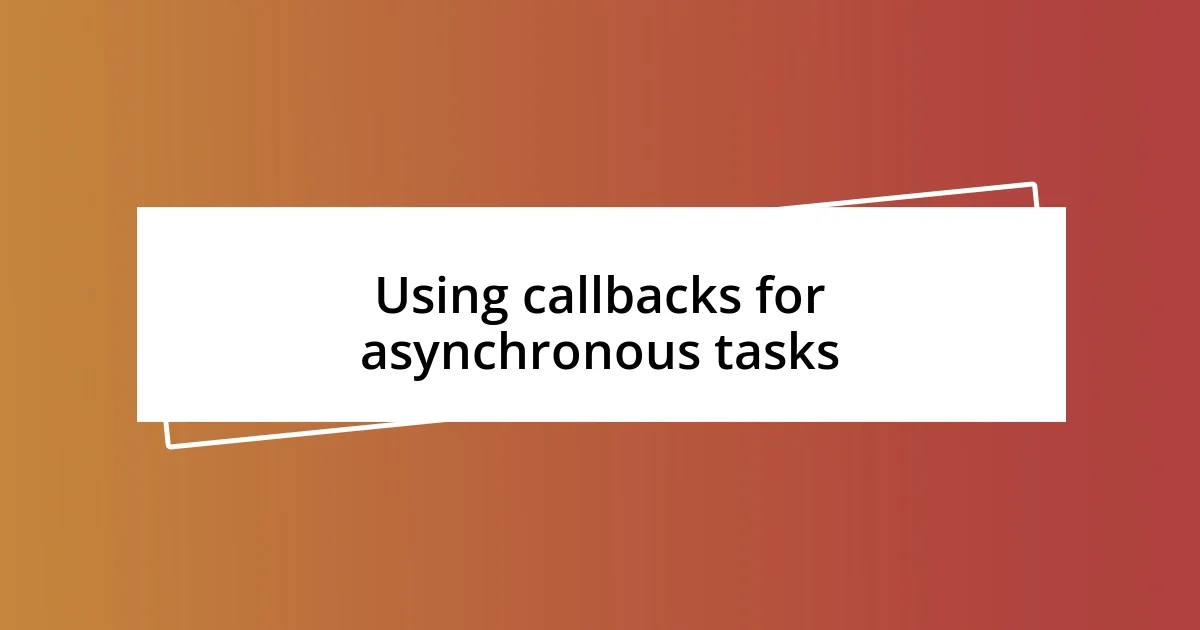Key takeaways:
- Understanding asynchronous programming enhances code responsiveness through efficient handling of tasks using callbacks, promises, and async/await.
- Common challenges include error handling, managing execution order, and avoiding race conditions, which can significantly affect application reliability.
- Implementing best practices like keeping functions focused, utilizing Promise.all(), and managing timing improves code clarity and user experience.

Understanding asynchronous programming concepts
Asynchronous programming, at its core, allows JavaScript to perform non-blocking operations. I remember the first time I encountered callbacks—what a revelation! I found it thrilling to think that while one function was waiting on data, others could keep executing. Have you ever noticed how that magical flow keeps your app responsive, even when dealing with heavy tasks?
Promises introduced a clearer way to handle asynchronous tasks. Initially, I struggled with the concept—what exactly was a promise? But once I grasped it, it felt like a light bulb going off. Each promise represents a future value, giving us a structured way to manage callbacks without entering the “callback hell” territory. It’s amazing to think how a simple concept can drastically improve code readability and maintainability.
Then there are async/await, which changed everything for me. When I first used async functions, it felt as if I was gently ushering my code back to a synchronous style, but without losing the benefits of asynchronicity. Have you experienced that comforting sensation of writing code that reads almost like a narrative? Those small victories—like reducing complexity and avoiding nesting—have made my coding journey all the more enjoyable.

Common challenges with asynchronous code
As I dove deeper into asynchronous programming, I encountered various challenges. One prominent issue is error handling. When working with callbacks, I found it easy to lose track of errors, especially when they bubbled up through multiple layers. I distinctly remember a project where a simple type error brought the whole application to its knees, leading to countless hours of debugging. It made me appreciate the clarity that try/catch offers with async/await.
Another common struggle is managing the execution order of asynchronous tasks. In one of my early projects, I underestimated the importance of sequencing tasks. I had multiple data fetching operations that, unfortunately, executed in an unintended order, causing data integrity issues. This experience taught me to always consider the implications of simultaneous operations and how critical it is to handle dependencies properly.
Lastly, race conditions can be a major headache. There was an instance where two asynchronous calls modified a shared resource, leading to unexpected results. It honestly felt like a scene out of a suspense thriller—waiting to see which call would complete first. Making sure that I understand how to control the flow of operations has since been vital in my coding practices.
| Challenge | Description |
|---|---|
| Error Handling | Difficulty in tracking and managing errors, especially in nested callbacks. |
| Execution Order | Unintended sequence of asynchronous operations leading to integrity issues. |
| Race Conditions | Conflicts arising from simultaneous asynchronous operations accessing shared resources. |

Using callbacks for asynchronous tasks
Using callbacks for asynchronous tasks can be a game changer, but they come with their own set of challenges. I vividly remember the first callback I implemented—it was exhilarating to realize I could start one task and set another function to run once that task was complete. However, the excitement quickly turned into frustration as I faced a tangled web of nested callbacks. It felt like digging a hole I couldn’t climb out of! That experience really highlighted the importance of keeping functions simple and managing callback flow effectively.
Here are some key points I learned along the way:
- Separation of Concerns: I found that breaking down tasks into smaller, single-purpose functions helps maintain clarity and avoid confusion.
- Error Handling: Always include an error parameter in the callback to ensure you can catch issues early. I once neglected this in a project, resulting in a frustrating debugging marathon.
- Naming Conventions: Clear, descriptive naming for callback functions can significantly enhance readability. I wish I had better named my functions in the heat of the moment—those vague names still haunt me!
Embracing the intricacies of callbacks requires patience, but, trust me, it’s worth it for the responsiveness and efficiency you gain.

Implementing promises for cleaner code
Implementing promises transformed my experience with asynchronous code to a much clearer process. Initially, I was skeptical—could promises really simplify my workflow? However, when I started using them, I found that chaining .then() methods not only made the code more readable but also significantly reduced my reliance on deeply nested callbacks. It felt like I was finally gaining control over the chaos.
One memorable moment came when I refactored a particularly convoluted part of my application. I had a series of API calls that needed to happen in order, and I was worried about how to handle possible failures. When I switched to promises, I was able to catch errors at each step of the chain with .catch(). The relief I felt when the promise rejection didn’t lead me into a debugging nightmare was remarkable! Have you ever struggled with callbacks and wished for a simpler solution? Promises can be that beacon of hope.
Using promises helped me embrace a more functional style of coding. I began to see how beautiful it is to express asynchronous workflows as a sequence of operations. For instance, when performing data fetching and processing tasks together, I could compose them into a single pipeline of promises. This not only made my code cleaner but also brought a sense of elegance that I had been yearning for—like finding the missing piece to a puzzle. What’s more, I realized I spent less time managing the flow and more time innovating.

Leveraging async await for simplicity
Once I started using async and await, it was like flipping a switch. I remember the wave of relief that washed over me when I realized I could write asynchronous code that looked almost synchronous. By simply adding the async keyword before a function, I felt I could handle promises in a way that felt natural and intuitive—this was a game changer for my workflow.
Diving into async and await simplified my error handling immensely. I’ll never forget a late-night coding session where I faced a frustrating series of failed API calls. By using try and catch blocks, I was able to capture errors seamlessly. Instead of dealing with scattered .catch() methods across numerous promises, I could maintain clean and concise error handling right alongside my logic. Have you ever wished that error management could be less of a headache? This approach made it possible for me to focus more on the application’s functionality rather than getting lost in error propagation.
I also discovered that using await made my asynchronous code more readable, which ultimately led to fewer debugging sessions. I came across a scenario where I needed to retrieve user information before displaying it on the screen. With await, my code’s flow became so clear: it felt like following a well-marked path on a hike rather than stumbling through a dense fog. This clarity not only improved maintainability but also made it easier for my teammates to understand my thought process. How often do we code for ourselves versus for the team? Embracing async and await helped me bridge that gap, inviting collaboration by making my intentions crystal clear.

Error handling in asynchronous operations
Managing errors in asynchronous operations can often feel daunting. I remember working on a feature where user input triggered a chain of calls to a remote server. I naively assumed everything would work perfectly, but when it didn’t, I quickly learned the importance of robust error handling. Implementing try and catch blocks not only allowed me to manage errors gracefully but also made me rethink my approach to failure—what if not every request would succeed? This mindset shift helped me anticipate potential issues instead of being caught off guard.
One particular instance stands out: I was developing a task that displayed product information, relying on multiple API fetches. Initially, I just let errors bubble up, which left my users puzzled during the downtime. After I integrated error handling, I discovered the power of communicating with users through friendly error messages. Style the message to reassure them, “Something went wrong, but we’re on it!” By acknowledging the problem, I transformed what could have been a frustrating experience into one that felt more human and transparent.
Over time, I recognized that effective error handling is not just about capturing failures, but it’s also about learning from them. Each time my code stumbled, I asked myself: what can I do better next time? Taking the time to log errors and understand their root causes became a practice that enriched my understanding of the system. I even created a simple utility function to centralize my error logging. This proactive approach not only improved my code’s reliability but also spurred me on to write even more resilient applications. How often do we get to learn and grow from our mistakes? In programming, those lessons can be the cornerstone of crafting smoother user experiences.

Best practices for asynchronous JavaScript
As I dove deeper into asynchronous JavaScript, I found that managing the flow of my code became pivotal. One day, while refactoring an app to handle user uploads, I faced a complex nested structure filled with promises. It struck me: flattening my promise chains using Promise.all() not only optimized performance but also made my code much cleaner. There’s a sense of satisfaction that comes from simplifying a tangled web of callbacks into a more manageable format. Isn’t it amazing how a small change can make such a big difference?
Keeping my functions small and focused also became a best practice I swear by. I remember a project where I had this sprawling function that handled multiple asynchronous tasks. The result? My mind felt like a jumbled mess, and debugging became a nightmare. Once I began breaking that monolith into smaller, reusable functions, I could spot issues with much greater ease. Each function was like a tiny puzzle piece that contributed to the bigger picture—much less overwhelming! Have you ever restructured your code and felt that rush of clarity?
Lastly, I learned the importance of timing my asynchronous code wisely. I recall implementing a feature that displayed real-time notifications. I quickly realized that if I didn’t handle delays properly, users would see outdated information, leading to confusion. Using setTimeout() and managing intervals became crucial, as it helped ensure that the data being processed was not just timely but also relevant. How often do we consider the timing of updates in our applications? It’s a subtle aspect but one that profoundly impacts user experience and engagement.














